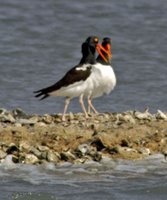Bird Tour by Boat

This morning ( at 7:30 !-ugh) we embarked on the M.V. Skimmer for a trip to Aransas National Wildlife Refuge. It was pleasantly warm with calm seas and a nice breeze. Aransas Bay is long, narrow, shallow (averages 3 feet) and full of birds.
The main object of the tour and the biggest reason most "birders" visit this area is to view the Whopping Crane. The world's only wild natural flock of whopping cranes has a standing reservation at the Aransas National Wildlife Refuge, about 45 minutes north of Rockport. The small flock of the continent's tallest bird journeys 2,500 miles south from Wood Buffalo National Park in Alberta, Canada to the protected habitat of the Texas refuge. 
The cranes stand nearly five feet tall and have a wingspan of eight feet.
There are just over 200 birds in this group here in Texas. We probably saw 30 to 40 today--a large portion of the entire known population.
We also saw NUMEROUS other birds-too many to list. There were a few people on the trip that were really into bird watching and they had their lists out so they could mark off each species they observed.
The tour captain has a sponsorship deal with Nikon Optics. The had a number of Nikon spotting scopes available for use as well as a number of pairs of Nikon Binoculars. Using the best Nikon Binoculars really made a difference in what we were able to see! Jim was quite pleased that the captain had a special adapter for his camera that turned the spotting scope into a 900 mm lens. Some of the shots here were taken with it.
These little birds are American Oyster Catchers. We especially liked their bright orange beaks which are strong enough and sharp enough to open oysters.
We came upon an island where there were about 20 Great Blue Herons "hanging out" in one of the trees. These large,grayish -blue birds are great fishermen. It is highly unusual to see so many in one area. Spring breeding time must be near!
One highly unusual site was the flamingo in the photo above this narrative. Pink Flamingoes are indigenous to Florida--not Texas. Speculation among local bird experts in that this young male was blown off course and away from the rest of his kind by last year's hurricanes. The bands on his legs were applied in the Yucatan Peninsula area of Mexico before his migration. The experts are hoping he will figure out that he does not belong here and move back to his normal habitat. He is the ONLY one of his kind in this area!
It was a fun tour. On the return trip the seas were a little rough but Karen did not get sea-sick. As some of you are aware, that has not always been the case, so that is a good thing!

<< Home